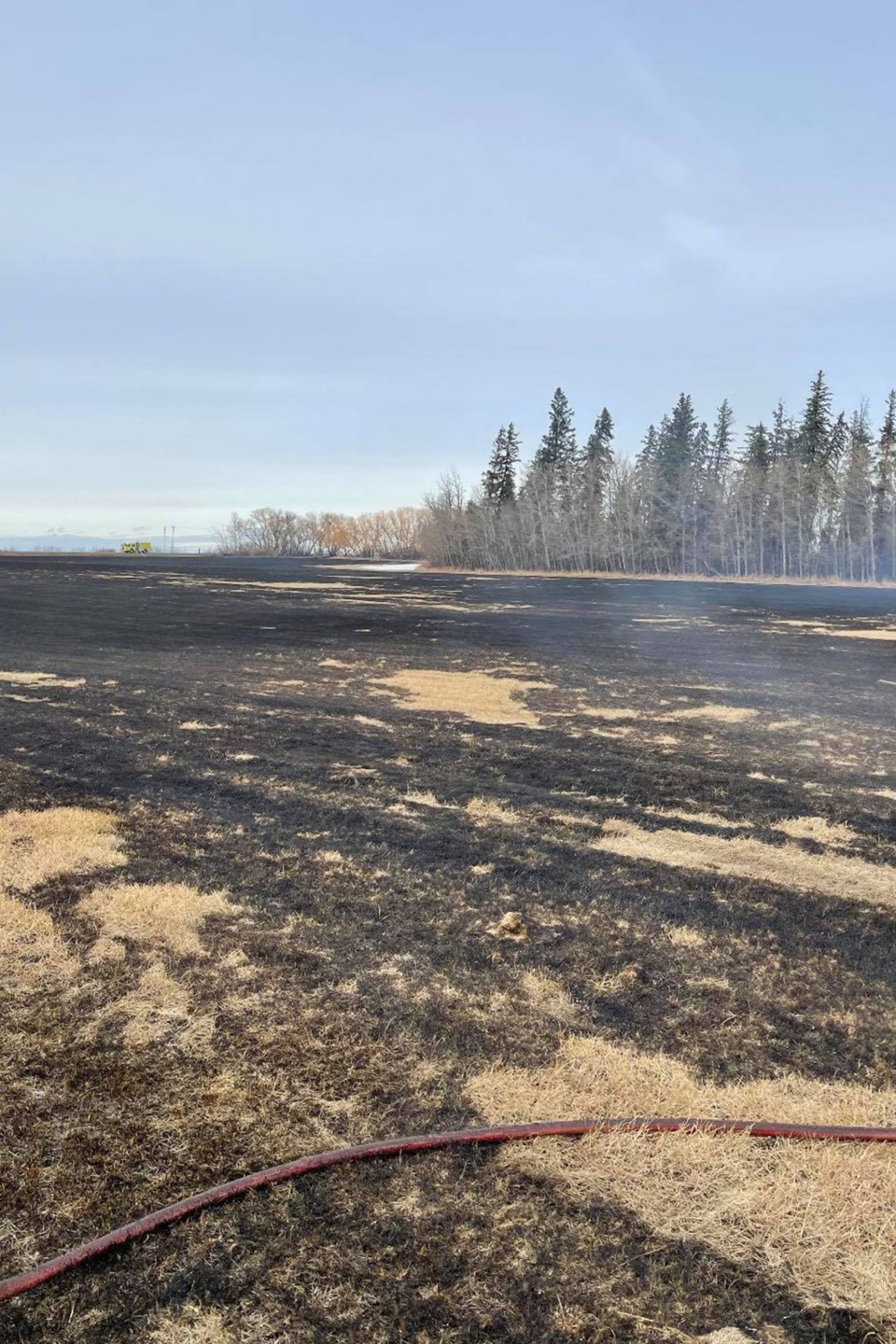St. Albert firefighters responded to the first grass fire of the season on Saturday, calling attention to dry conditions in the area.
Around 3:40 p.m. on March 27, crews were called to reports of a grass fire off Meadowview Drive near sod supplier Tee Bar Sod Farms Ltd.
Firefighters arrived on scene eight minutes later with a fire truck, fire engine and water tanker. The fire was out within 40 minutes, said Mike Bos, fire prevention officer. A large area of charred grass remains.
"It was a pretty small event, but significant that it's the first grass fire of the year," Bos said.
Early spring isn't usually a time when fire crews would expect to respond to grass fires, as rain showers and snow melt can make conditions inhabitable for sparks to catch, he said. But dry conditions this year were significant enough to outweigh how much snow or rainfall the area's seen recently.
"The weather conditions really may not have been conductive to it, but we haven't had a huge amount of snow. Now the snow's all melted off, we've got a lot of dry, dead grass out there. It's pretty easy to light that on fire, even when conditions aren't optimal."
The cause of the fire has not been confirmed, but the fact that it was next to the road offers an important clue, Bos said.
"Something like this adjacent to the road, what we normally look at first is a cigarette, so somebody may have discarded a cigarette outside. Or perhaps, somebody driving in taller grass. That also has the potential to to start the grass on fire."
Simply throwing a half-lit cigarette butt out the window may seem like a mindless action, but it can have damaging consequences. Bos said residents need to remember not to dispose of cigarettes outside of your vehicle. Even while walking, make sure the cigarette is completely extinguished before throwing it away.
"Just be cautious. If you're driving a vehicle where there's grass or if you're walking in an area and you're smoking, make sure that your cigarettes are properly put out and that you're exercising caution. That's the main thing," he said. "We've got a lot of fields here in our area around the city, so it's pretty important to be cognizant of that."
Driest winter in 115 years
Kyle Fougère, meteorologist with Environment and Climate Change Canada, said the Edmonton area saw the second driest winter on record this year, surpassed only by measurements recorded in 1906.
"It's been very dry in central Alberta," Fougère said.
Typically, the area would see 59 millimetres of precipitation from December to February, he explained. This year, the area saw only 14.5 millimetres of precipitation over those three months. March hasn't fared any better – only 2.2 millimetres of precipitation fell during the first month of spring, far below typical measurements of 18.5 millimetres.
"Dry conditions and the wind is what made it a dangerous situation for grass fires," he said. "Although there was some precipitation on that day, there wasn't a lot and not enough to alleviate the conditions that we had existing."
The previous two winters saw near or above normal precipitation levels, but drier conditions have become a trend in this part of the province. The last time the area saw an above-normal year for precipitation was back in 2005, he said.
Weather systems tend to vary pretty significantly across the province, Fougère explained. This year, cold air coming from the Arctic in the winter didn't carry a lot of precipitation with it. Any rainfall stayed down in southern Alberta.
"It was really the way the weather systems lined up this year and the reason that we in central Alberta didn't get a lot of precipitation while other places did."
Ice safety
Ice and fire really became two separate issues in St. Albert over the weekend.
While crews were responding to the grass fire, a photo began circulating social media showing two people and their dogs walking on visibly thin ice on a storm pond in St. Albert. Had someone fallen through, there could have been a delay in how fast crews were able to respond, Bos explained.
"If you fall through the ice and you need some assistance, or you need to be rescued, there could possibly be a delayed response if we're out working somewhere else," Bos said. "We may have to have another station come from the other side of the city to come and deal with that issue."
Throughout the winter, the St. Albert fire department have been vocal in telling people to not walk on any body of ice, but the risk is especially high at this time of year, he said. Warmer temperatures add an extra layer of uncertainty, as ice thickness can vary drastically while the snow melts.
Despite this, St. Albert firefighters reported numerous instances of people testing thin sheets of ice as temperatures warm up in the last week.
"It's a little scary that people would actually, at this time of year, go on ice anywhere. That's hugely concerning for us," Bos said.



